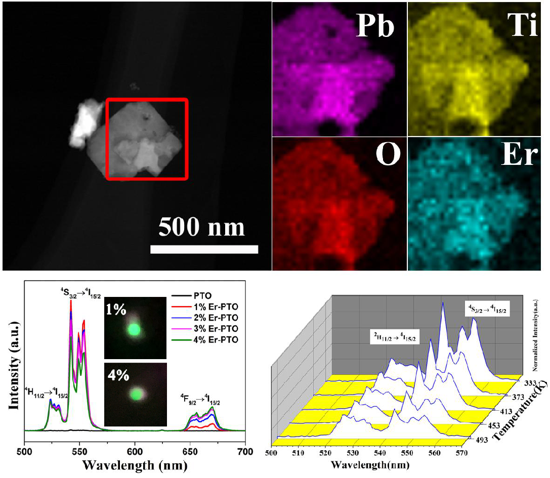Up-conversion luminescence (UCL) materials doped with rare earth (RE) ions have deserved soaring attention in the past decades because of their excellent properties and potential applications in color displays, temperature sensor devices, drug delivery, photovoltaic, cell imaging and tumor therapy.
Generally, the emission efficiency of the UCL materials are determined by activators, sensitizers and crystalline hosts. Among them, a careful selection of host materials is required to achieve efficient UC emission. Perovskite-type oxides (ABO3), including of SrTiO3, are intensively studied as the host materials. On the one hand, the perovskite-type oxides have adjustable crystal structure, and the radius of A-site ions (Ca2+, Pb2+, Ba2+ and Sr2+) and B-site ion of Ti4+ are close to the radius of lanthanide ions. Consequently, the introduction of lanthanide ions into the crystal lattice of perovskite oxides has highly practical viability. On the other hand, the perovskite-type oxides have excellent physical properties, chemical stability and low lattice phonon energies, which are regarded as one of the most promising host materials for various applications.
Meanwhile, the doping concentration has an obvious influence on emission efficiency. To obtain high emission efficiency, a sensitizer is commonly co-doped into UCL hosts along with the activators. While UCL materials doped with rare earth (RE) ions have been reported, their performance has been severely limited by the doping ion concentration, and the UC properties of rare-earth ions doped PbTiO3 with nanoparticle morphology is rarely reported, as well as the temperature sensing properties. Therefore, developing Er-PTO nanoparticles is of paramount importance.
Recently, the research group led by Han from Zhejiang University verified the UCL intensity of Er3+-doped PbTiO3 nanofibers can be modulated by changing the phase structure and polarization of the host matrix. When the Er3+ ions doped into pre-perovskite or perovskite PbTiO3 nanofibers, due to the differences of substitution sites and chemical environments, the pre-perovskite one had no UC emission, whereas the perovskite one exhibited green and red emissions. Moreover, the UCL emissions could be modulated by adjusting the tetragonality of the perovskite PbTiO3 nanofibers.
Based on the above work, Dr. Zhen Xiao et al from China Jiliang University have carried out a series of innovative research, and the relevant results are published in the second issue of Chinese Optics Letters, Vol. 19, No. 2, 2021 (Jing Zhu, Shiqing Xu, Lei Lei, Feifei Huang, Zhen Xiao. Empowering perovskite PbTiO3 nanoparticles with enhanced up-conversion luminescence and thermal sensitivity by introducing Er3+ dopant[J]. Chinese Optics Letters, 2021, 19(2): 021601).

Plots of UC emission spectra versus the Er3+ doping concentration and temperature of Er-PTO nanoparticles upon 980 nm excitation
In this work, we prepared a serious of perovskite Er-PTO nanoparticles with different Er3+ doping concentrations by a facile hydrothermal method. The influences of dopant concentration on the morphology, microstructure and UCL properties were investigated in detail. Green and red emissions centered at 520, 550 and 660 nm are observed. The perovskite Er-PTO nanoparticles fabricated in this work present a great improvement in the UC luminescence. Both green and red emissions of PbTiO3 samples can be enhanced by doping Er3+ ions.
Moreover, the UC luminescence versus temperature also has been investigated. According to the fluorescence intensity ratio technique, which is a noncontact measurement with high sensitivity, high signal discriminability and broad range dynamic imaging, Er-PTO samples with doping 1 mol% concentration of Er3+ ions possess a sensitivity of 3.1×10-3 K-1 at 474 K. The excellent UCL performance and thermal sensitivity of Er-doped ferroelectric materials indicated the great potential for multifunctional applications. By applying these Er-PTO samples into a temperature sensor link, the transmission rate will be significantly increased, which is a potential application in temperature detection and alarm.
Dr. Zhen Xiao said that her work presented the excellent emission intensity performance at room temperature. Moreover, the application of these UCL materials at high temperature has also been demonstrated. Future work will focus on the further optimizations of the UCL materials and optical set up in order to fully explore and realize the potential of these UCL materials. Furthermore, UCL materials doped with different RE ions at low temperature will be studied and constructed in the future.


